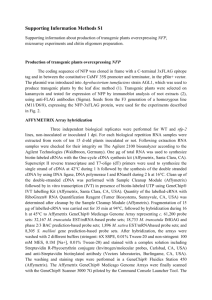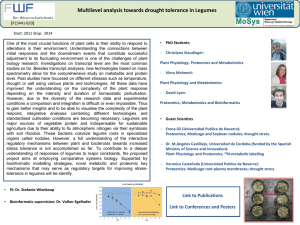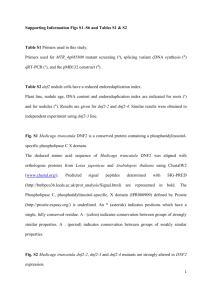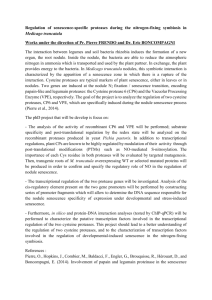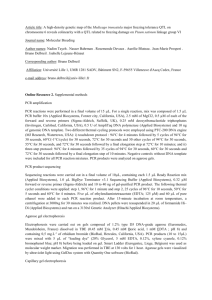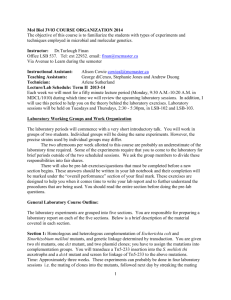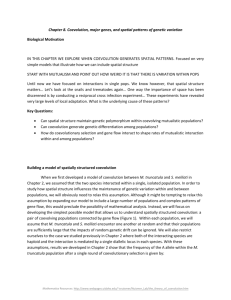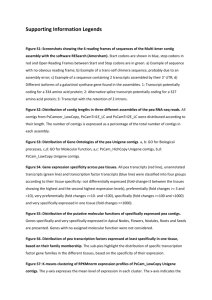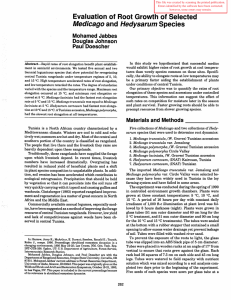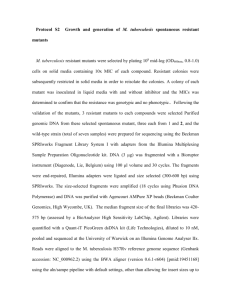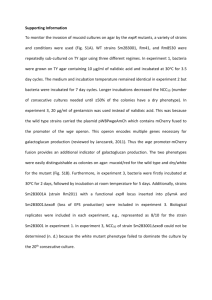genetic 108
advertisement
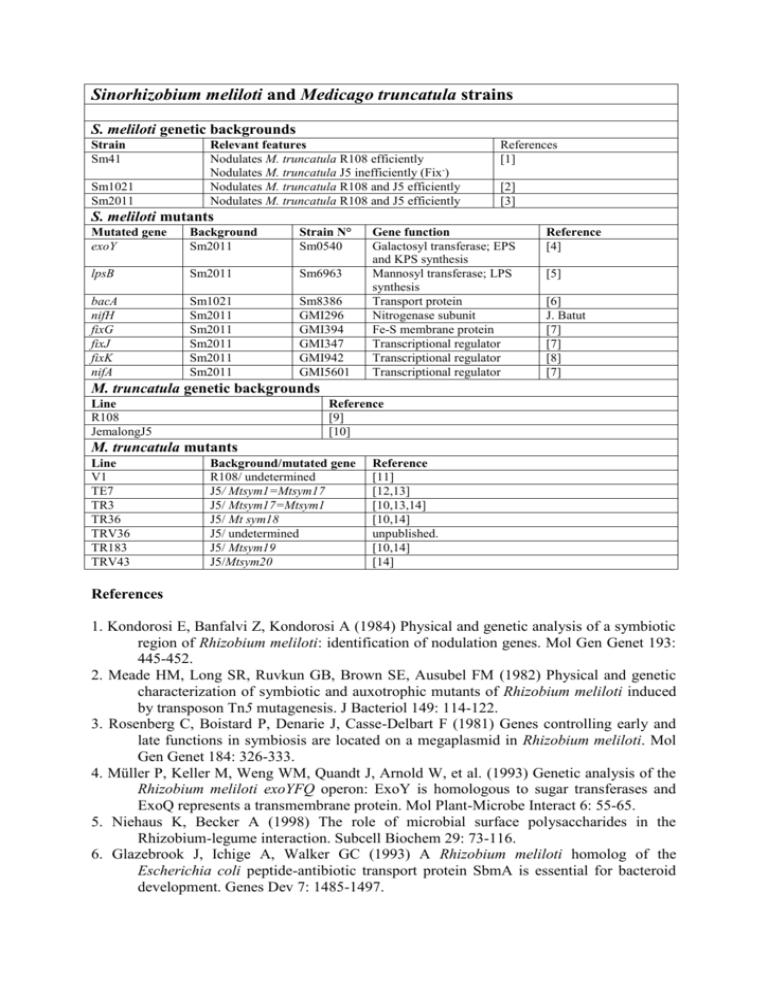
Sinorhizobium meliloti and Medicago truncatula strains S. meliloti genetic backgrounds Strain Sm41 Sm1021 Sm2011 Relevant features Nodulates M. truncatula R108 efficiently Nodulates M. truncatula J5 inefficiently (Fix-) Nodulates M. truncatula R108 and J5 efficiently Nodulates M. truncatula R108 and J5 efficiently References [1] [2] [3] S. meliloti mutants Mutated gene exoY Background Sm2011 Strain N° Sm0540 lpsB Sm2011 Sm6963 bacA nifH fixG fixJ fixK nifA Sm1021 Sm2011 Sm2011 Sm2011 Sm2011 Sm2011 Sm8386 GMI296 GMI394 GMI347 GMI942 GMI5601 Gene function Galactosyl transferase; EPS and KPS synthesis Mannosyl transferase; LPS synthesis Transport protein Nitrogenase subunit Fe-S membrane protein Transcriptional regulator Transcriptional regulator Transcriptional regulator Reference [4] [5] [6] J. Batut [7] [7] [8] [7] M. truncatula genetic backgrounds Line R108 JemalongJ5 Reference [9] [10] M. truncatula mutants Line V1 TE7 TR3 TR36 TRV36 TR183 TRV43 Background/mutated gene R108/ undetermined J5/ Mtsym1=Mtsym17 J5/ Mtsym17=Mtsym1 J5/ Mt sym18 J5/ undetermined J5/ Mtsym19 J5/Mtsym20 Reference [11] [12,13] [10,13,14] [10,14] unpublished. [10,14] [14] References 1. Kondorosi E, Banfalvi Z, Kondorosi A (1984) Physical and genetic analysis of a symbiotic region of Rhizobium meliloti: identification of nodulation genes. Mol Gen Genet 193: 445-452. 2. Meade HM, Long SR, Ruvkun GB, Brown SE, Ausubel FM (1982) Physical and genetic characterization of symbiotic and auxotrophic mutants of Rhizobium meliloti induced by transposon Tn5 mutagenesis. J Bacteriol 149: 114-122. 3. Rosenberg C, Boistard P, Denarie J, Casse-Delbart F (1981) Genes controlling early and late functions in symbiosis are located on a megaplasmid in Rhizobium meliloti. Mol Gen Genet 184: 326-333. 4. Müller P, Keller M, Weng WM, Quandt J, Arnold W, et al. (1993) Genetic analysis of the Rhizobium meliloti exoYFQ operon: ExoY is homologous to sugar transferases and ExoQ represents a transmembrane protein. Mol Plant-Microbe Interact 6: 55-65. 5. Niehaus K, Becker A (1998) The role of microbial surface polysaccharides in the Rhizobium-legume interaction. Subcell Biochem 29: 73-116. 6. Glazebrook J, Ichige A, Walker GC (1993) A Rhizobium meliloti homolog of the Escherichia coli peptide-antibiotic transport protein SbmA is essential for bacteroid development. Genes Dev 7: 1485-1497. 7. David M, Daveran ML, Batut J, Dedieu A, Domergue O, et al. (1988) Cascade regulation of nif gene expression in Rhizobium meliloti. Cell 54: 671-683. 8. Foussard M, Garnerone AM, Ni F, Soupene E, Boistard P, et al. (1997) Negative autoregulation of the Rhizobium meliloti fixK gene is indirect and requires a newly identified regulator, FixT. Mol Microbiol 25: 27-37. 9. Hoffmann B, Trinh TH, Leung J, Kondorosi A, Kondorosi E (1997) A new Medicago truncatula line with superior in vitro regeneration, transformation, and symbiotic properties isolated through cell culture selection. Mol Plant-Microbe Interact 10: 307315. 10. Sagan M, Morandi D, Tarenghi E, Duc G (1995) Selection of nodulation and mycorrhizal mutants in the model-plant Medicago truncatula (Gaertn.) after gamma-ray mutagenesis. Plant Sci 111: 63-71. 11. Mergaert P, Nikovics K, Kelemen Z, Maunoury N, Vaubert D, et al. (2003) A novel family in Medicago truncatula consisting of more than 300 nodule-specific genes coding for small, secreted polypeptides with conserved cysteine motifs. Plant Physiol 132: 161-173. 12. Bénaben V, Duc G, Lefebvre V, Huguet T (1995) TE7, an inefficient symbiotic mutant of Medicago truncatula Gaertn. cv Jemalong. Plant Physiol 107: 53-62. 13. Sagan M, De Larembergue H, Morandi D (1998) Genetic analysis of symbiosis mutants in Medicago truncatula. In: Elmerich C, Kondorosi A, Newton WE, editors. Biological Nitrogen Fixation for the 21st Century: Kluwer. pp. 317-318. 14. Morandi D, Prado E, Sagan M, Duc G (2005) Characterisation of new symbiotic Medicago truncatula (Gaertn.) mutants, and phenotypic or genotypic complementary information on previously described mutants. Mycorrhiza 15: 283-289.
